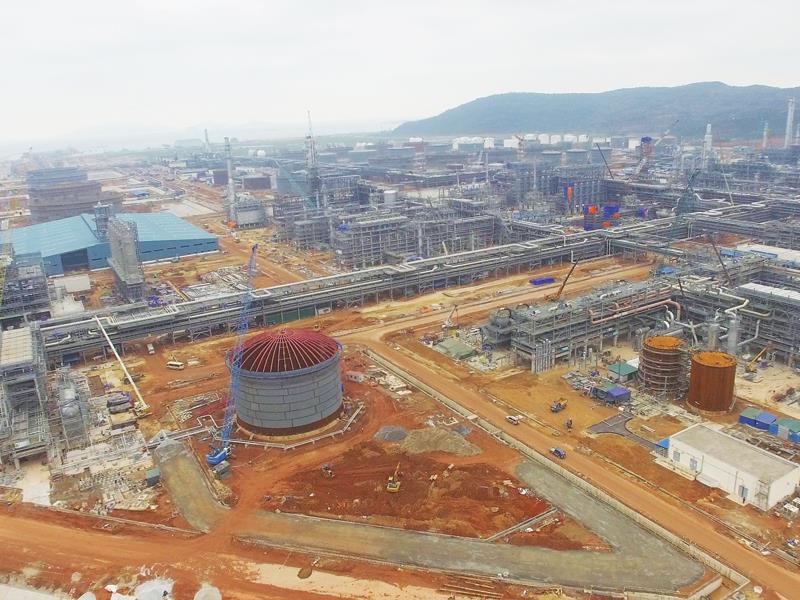Nghi Son refinery might prove costly endeavour to investor and state
 |
The test run of Nghi Son complex is going to last from November 2016 to June 2017. Then, in July, the complex is going to start commercial operation, hoping to reach full capacity by 2020.
Licensed in 2008, Nghi Son complex in the central province of Thanh Hoa’s Nghi Son economic zone, in which PetroVietnam has a 25.1 per cent stake, Kuwait Petroleum International 35.1 per cent, Idemitsu Kosan 35.1 per cent, and Mitsui Chemical International 4.7 per cent, has the total investment capital of $9 billion.
According to the agreement signed between the investors of the complex and the Vietnamese government, state-owned national oil and gas group PetroVietnam has to buy any amount of products that the company running the refinery complex, Nghi Son Refinery and Petrochemicals LLC (NSRP) wants to sell for 10 years, at the price of imported products plus 7 per cent for refinery products, 5 per cent for LPG, and 3 per cent for petrochemical products.
Because this price is preferable to exporting its products, the company is likely to sell all its output to PetroVietnam and refrain from exporting.
Therefore, during these 10 years, PetroVietnam is going to pay $1.54 billion more to buy these products than it would otherwise spend on distributing imported products in Vietnam. This is $154 million per year.
PetroVietnam has been seeking a way out since September 2015. PetroVietnam calculated that with WTI crude oil assumed at $75 per barrel, with on-going import duties, this sum would be about VND65 trillion ($2.98 billion) for petroleum items and VND10 trillion ($458 million) for petro-chemical items.
The new $1.54 billion figure that the department reported was recalculated based on the crude price assumption of $45 per barrel and current import duties. The department said that the higher the price of crude oil, the higher this sum is going to be. At $50 per barrel the sum is going to be $1.8 billion. At $70, it will reach $2 billion.
PetroVietnam, as a stakeholder, earns a profit of VND1.6 trillion ($71.7 million) per year if the price of crude stays at $45 per barrel. If the price is $50 per barrel, the profit is going to be VND1.4 trillion ($62.8 million) per year. Take this number and subtract from it the recalculated sum above, ultimately, when the refinery complex starts operation, PetroVietnam will lose at least $80 million per year.
The government has not responded to PetroVietnam’s proposals on how it can make up for this loss.
On the other hand, the refinery complex is going to decrease state budget revenue, too.
NSRP enjoys a preferential CIT of 10 per cent for 70 years, a 4-year tax exemption when the company starts making taxable income, and a 50 per cent tax cut for the next nine years. Counting the VAT, excise, and environment protection tax that NSRP has to pay in 2017-2020, and subtracting the amount of import tariff that the budget will miss out on in the period because of decreased imports, the 2017 budget is going to decrease by VND1.37 trillion ($61.4 million). In 2018, 2019, and 2020 the decrease will grow more serious, to VND10.9 trillion ($488.7 million), VND10.6 trillion ($475.3 million), and VND14.1 trillion ($632.2 million).
What the stars mean:
★ Poor ★ ★ Promising ★★★ Good ★★★★ Very good ★★★★★ Exceptional
Latest News
More News
- Vietnam’s GDP forecast to grow by 9 per cent in 2026 (December 29, 2025 | 08:29)
- Women entrepreneurs are key to Vietnam’s economic growth (December 29, 2025 | 08:00)
- Vietnam's top 500 value-creating enterprises announced (December 27, 2025 | 08:00)
- The PAN Group shaping a better future with ESG strategy (December 26, 2025 | 09:00)
- Masan Consumer officially lists on HSX, marking the next phase of value creation (December 25, 2025 | 13:20)
- MCH to become the largest consumer stock on VN-Index (December 24, 2025 | 11:05)
- Oil and gas firms post strong 2025 results (December 22, 2025 | 17:42)
- SABECO wins multiple international beer awards (December 22, 2025 | 17:41)
- UOB sees Vietnam growth easing in fourth quarter (December 22, 2025 | 17:39)
- First members of Danang International Finance Centre revealed (December 22, 2025 | 17:39)

















 Mobile Version
Mobile Version